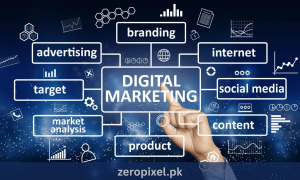The world of marketing and advertising has changed dramatically in the fast-paced era of technological advancement. Driven by the internet and different online platforms, digital marketing has become a powerful force that is changing print media as well as other traditional advertising mediums. The printing industry has faced both opportunities and challenges as a result of this evolution, which has drastically changed how companies interact with their target markets.
Table of Contents
ToggleWhat are the Instrumental to the Digital Marketing?
Digital marketing encompasses a vast range of online tactics to increase customer engagement, brand recognition, and sales. Businesses nowadays have an abundance of tools at their disposal to reach potential customers in the digital space. Our digital marketing expertise ranges from pay-per-click (PPC) advertising and social media campaigns to email marketing and search engine optimization (SEO). Because of this, traditional print advertising has become less in demand, which has forced printing media to adjust to the shifting nature of the market.
How to Fortify Digital Marketing Campaigns
The move toward targeted and customized advertising is one of the biggest effects of digital marketing on print media. Digital marketing gives advertisers the ability to customize their messages according to online behavior, interests, and demographics, in contrast to traditional print ads that reach a wide audience. Businesses can develop highly customized campaigns that resonate with particular audience segments by utilizing data analytics and consumer insights. This degree of targeted precision maximizes return on investment for advertisers while also improving the efficacy of marketing campaigns.
Why Digital Marketing are Priority
In comparison to print advertising, digital marketing provides unmatched flexibility and scalability. With digital platforms, advertisers can experiment with different messaging formats, optimize performance based on analytics, and make real-time adjustments to their campaigns. Because of their agility, businesses are able to adapt quickly to shifting consumer trends and competitive dynamics and remain flexible in a market that is changing quickly. On the other hand, traditional print advertisements are less flexible to adjust to changing market conditions because they have fixed placements and lengthy lead times.
Digital Marketing is Cheaper in Expense
The cost-effectiveness of digital marketing in comparison to traditional print advertising is another important benefit. While reaching a larger audience through print media frequently requires significant production and distribution costs, digital channels provide a more affordable option. Businesses of all sizes can promote their goods and services at reasonable costs by using online channels like social media, email, and search engines. Furthermore, real-time tracking and measurement of campaign performance is made possible by digital marketing, which empowers advertisers to make better-informed decisions and maximize their marketing budgets.
Even with digital marketing becoming more and more dominant, print media is still essential to the advertising ecosystem. High-quality printed materials that target particular audiences still have a niche market, even though print circulation may have decreased in some segments. For example, luxury brands frequently use print media to communicate an air of exclusivity and prestige, leveraging the tactile and visual appeal of printed materials to draw in wealthy customers. Furthermore, print magazines aimed at niche markets, like hobbyists or enthusiasts, present advertisers with a special chance to interact with enthusiastic readers in a pertinent setting.
Synching with Traditional Marketing
In today’s marketing environment, integrating print and digital advertising strategies has become more commonplace. Instead of seeing print and digital media as rival platforms, Companies are using the advantages of each media to develop campaigns that work well together and strengthen their brand messaging. To bridge the gap between offline and online experiences, for instance, QR codes and augmented reality elements are being added to print ads. This keeps print media tangible while directing traffic to digital platforms.
Bottom Line
In conclusion, the way that digital marketing has affected print media highlights how dynamic the advertising sector is and how important it is to be flexible in the face of technological change. Even though digital channels are unmatched in terms of reach, targeting, and measurability, print media still has a special place in some situations. Businesses can create comprehensive marketing campaigns that resonate with consumers across multiple touchpoints by embracing the convergence of digital and print advertising. The mutually beneficial relationship between digital marketing and technology is growing and for years to come, printing media will keep influencing how advertising develops.


